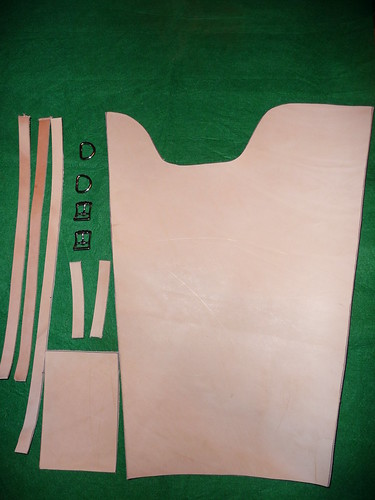For Convolution 2014, I wore the outfit I had created as the Masquerade entry along with a friend, where we did a cross-play skit with Han & Leia (or Hannah and Lee, if you will).
I
LOVE love love this costume, and will probably be wearing it as a hall costume at multiple conventions. I even bought a Wookie backpack to wear it around for the evening (which was great for holding my knitting projects! (Plus, he's super cute...and well, WOOKIE BACKPACK!
Our Masquerade skit at ConVolution went off a smashing success, and we got the award "Judges' Choice: Funniest Presentation", which pleased us to no end. A video of the full masquerade is available on YouTube; we are at about the 20 minute mark as we were the "finale" to the masquerade.
Our skit is at the 20 minute mark.
I wanted to write a summation post about Han's outfit, which included what I learned and reality vs. expectation so that it might help other costumers create their own version.
From the onset, Han's costume looks relatively easy, but there are some complex considerations, especially if you want to make something that would pass the
Rebel Legion's specification (if they allowed cross-play). Certainly, a lot of these costume pieces can be purchased; there are many places where you can purchase pre-made Han Solo costumes, but I wanted the satisfaction of making it myself.
As mentioned in
my preliminary post, I wanted to use / re-use as much as I could (i.e. fabric from my Stash, items I already had, etc), and spend as minimal as possible, but I also wanted to make the parts I was creating as screen accurate as possible within the timeline I had. I already had the following: the black leather belt, the black leather
boots, the gun holster. So, it was just matter of making the rest.
It took me about 6.5 weeks to make the costume working on it a few hours each week and some dedicated hours on the weekends -- starting a week after SDCC (end of July) to 2 weeks before ConVolution 2014.
Good luck! If you have any questions, feel free to email me or leave a comment.
And may the Force be with you.
Costume Summation
The following is a summation of each of the posts, along with resource links and suggested patterns. I'll be slowly adding to and modifying my Han Solo outfit -- making a
more screen accurate black belt, getting better boots, etc., I'll post
about those as I come to them and update this post when I do.
Making the Shirt
For the shirt, I created my own pattern, because I didn't like the initial pattern I intended to use. However, there are a number of commercial patterns that can be easily modified to create the shirt. As I already had plenty of muslin lying around, there was little cost in making this piece.
The Rebel Legion has the following guidelines for this shirt:
"White or cream color long-sleeve shirt with placket v-neck and short
mandarin collar." So you have plenty of lee-way in creating it.
- Post: Making the Shirt
- Suggested Patterns: Simplicity 1286. You'll need to modify the collar.
Making the Pants:
For this piece, I purchased 5 yards of navy blue denim (100% cotton) fabric using one of their 50% coupon. I spent about $40.00 on the fabric and $10.00 of Guterman regular red thread for the embroidery machine (you don't need "specific" embroidery thread). The pants pattern was about $1.00 on sale at JoAnns; I suggest waiting for one of their pattern sales that they have on a regular basis.
The Rebel Legion guidelines are: Dark blue or navy pocketless pants with accurate red Corellian bloodstripes. But when you add the riding seam, pintuck, and
embroidered stripe, you have "formal" Han Solo pants per the Rebel
Legion specifications.
The riding seam was fairly easy to add as was the pintuck. However, I recommend having another person help you align the pintuck correctly after you have created your mockup. Make sure to make a full (or nearly full) mockup to ensure that the fit is correct with the pintuck, riding seam, and blood stripes.
Making the Vest:
For this piece, I modified an existing pattern I drafted. In addition, I already had a medium weight black cotton/denim twill, so there was little monetary cost. However, it took quite a bit of time to ensure that the pockets were correct AND to scale on my body. I had to remake the pockets twice to get the right "depth". For me, this vest took the longest to get it to look right.
I highly recommend making a full mockup out of muslin before working your fabric.
Modifying the Blaster & Holster
The toy blaster from Amazon cost $10 with shipping, and the spray paint was another $15.00. I already had the gun belt, but a new holster needed to be made to fit the gun.
Other Costume Elements
There are other costume elements, such as the items Han wears on his belt (i.e. droid caller, bits & bobs.) You can purchase the droid caller at
Corellian Exports. I went without these elements, as I felt that the major parts I created were pretty iconic and easily recognizable as Han Solo. However, if you want to go for complete screen accuracy, I suggest getting these other elements.
Additional Resources:
The following are some additional resources that were extremely helpful to me during the making of the costume:


























